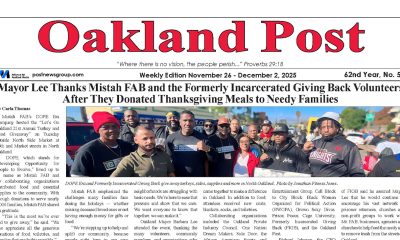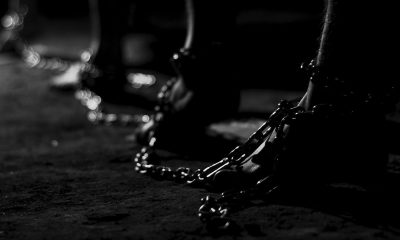Black History
Inside the Kingdom of Hayti, ‘the Wakanda of the Western Hemisphere’
MINNESOTA SPOKESMAN-RECORDER — The fictional kingdom has a real-life corollary in the historic Kingdom of Hayti.
By Marlene Daut
Marvel’s blockbuster Black Panther, which recently became the first superhero drama to be nominated for a Best Picture Academy Awards, winning three, takes place in the secret African Kingdom of Wakanda. The Black Panther, also known as T’Challa, rules over this imaginary empire — a refuge from the colonialists and capitalists who have historically impoverished the real continent of Africa.
But fans of the box-office hit might not realize that they don’t need to look to the make-believe world of the Black Panther to find a modern-day Black kingdom that aspired to be a safe haven from racism and inequality.
The fictional kingdom has a real-life corollary in the historic Kingdom of Hayti, which existed as a sort of Wakanda of the Western Hemisphere from 1811 to 1820.
The Haitian Revolution led to the creation of the first free Black state in the Americas. But the world was hardly expecting a former enslaved man named Henry Christophe to make himself the king of it.
Media accounts from the era, some of which I’ve collected in a digital archive, serve as a window into a brief period of time when the kingdom stood as a beacon of Black freedom in a world of slavery. Yet, like Wakanda, the Kingdom of Hayti wasn’t a utopia for everyone.
A new kind of kingdom
On Jan. 1, 1804, an army led by former enslaved Africans in the French colony of Saint-Domingue staved off France’s attempt to bring back slavery, and declared themselves independent and free forever.
The leader of the revolutionaries, General Jean-Jacques Dessalines, had defeated Napoleon’s famous army and made himself emperor of the newly-renamed Haiti.
But in October 1806, Dessalines was assassinated by political rivals, leading the country to be divided into two separate states: General Henry Christophe named himself president of the northern part of Haiti, while General Alexandre Pétion governed a completely separate republic in the southern and southwestern part of the country.
In March 1811, President Henry Christophe surprised everyone when he anointed himself King Henry I and renamed the northern republic, the Kingdom of Hayti. Henry I soon had a full court of nobles that included dukes, barons, counts and knights to rival that of royal England.
Haiti’s first and only kingdom immediately attracted the attention of media outlets from around the world. How could there be a republic on one side of the island and a monarchy on the other, they wondered? Was the new Black king trying to mimic the same white sovereigns who had once enslaved his people, others asked?
The edicts establishing the royal order of Haiti were immediately translated into English and printed in Philadelphia, while many American and British newspapers and magazines ran celebrity profiles of the Haitian king.
One newspaper described him as “the elegant model of an Hercules.” Another described him as “a remarkably handsome, well-built man; with a broad chest, square shoulders, and an appearance of great muscular strength and activity.”
The ‘First Monarch’ of the ‘New World’
In 1813, construction of the opulent Sans-Souci Palace – meaning literally “without worry” – was completed. The palace was partially destroyed by an earthquake in 1842; today, its remains have been designated a world heritage UNESCO site. During its heyday, the palace dazzled.
There were the elegantly manicured gardens and a unique, domed cathedral. The structure was flanked by a dramatic double staircase leading to the entryway and two arches detailed with etchings and inscriptions. One acknowledged Henry, rather than Jean-Jacques, as the country’s “founder.”
There were also two painted crowns on the principal palace façade, each of which stood at 16 feet tall. The one on the right read “To the First Monarch Crowned in the New World.” The one on the left said “The Beloved Queen Reigns Forever Over Our Hearts.”
King Henry lived in the palace with his wife, Queen Marie-Louise, and his three children, Prince Victor Henry, and the princesses, Améthyste and Athénaire.

An April 1815 issue of The Gazette Royale details how the Kingdom of Hayti foiled France’s attempt to reconquer its former colony.
Newspapers around the world reprinted articles from the monarchy’s official newspaper, the Gazette Royale d’Hayti, detailing the royal family’s lavish dinners, replete with bombastic speeches and lengthy toasts to famous contemporary figures such as King George III of England, U.S. President James Madison, the King of Prussia, and the “friend of humanity,” the “immortal” British abolitionist Thomas Clarkson.
The Gazette also recounted the decadence of Queen Marie-Louise’s August 1816 official birthday celebration, which lasted for 12 days and had 1,500 people in attendance. On the final day of the party, 12 cannons fired after the Duke of Anse toasted the queen as “the perfect model of mothers and wives.”
A free island in a sea of slavery
There was much more to King Henry’s reign than luxurious parties.
On March 28, 1811, King Henry installed a constitutional monarchy, a move lauded by many in the British elite. The famous British naturalist Joseph Banks championed Henry’s 1812 book of laws, titled the “Code Henry,” calling it “the most moral association of men in existence.”
“Nothing that white men have been able to arrange is equal to it,” he added.
Banks admired the code’s detailed reorganization of the economy, from one based on slave labor to one – at least in theory – based on free labor. This transformation was wholly fitting for the formerly enslaved man-turned-king, whose motto was “I am reborn from my ashes.”
The code provided for shared compensation between proprietors and laborers at “a full fourth the gross product, free from all duties,” and it also contained provisions for the redistribution of any land that had previously belonged to slave owners.
“Your Majesty, in his paternal solicitude,” one edict reads, “wants for every Haytian, indiscriminately, the poor as well as the rich, to have the ability to become the owner of the lands of our former oppressors.”
Henry’s stated “paternal solicitude” even extended to enslaved Africans. While the Constitution of 1807 had announced that Haiti would not “disturb the regimes” of the colonial powers, royal Haitian guards regularly intervened in the slave trade to free captives on foreign ships that entered Haitian waters.
An October 1817 issue of the Gazette celebrated the Haitian military’s capture of a slave ship and subsequent release of 145 of “our unfortunate brothers, victims of greed and the odious traffic in human flesh.”
Too good to be true?
Yet life in the Kingdom of Hayti was far from perfect.
Henry’s political rivals noted that people frequently defected to the southern Republic of Haiti, where they told stories of the monarch’s favoritism and the aristocracy’s abuse of power.

[/media-credit] Illustrator Mahlon Blaine depicts King Henry on the cover of the 1928 book Black Majesty.
Worse, Henry’s famous fortress, the Citadelle Laferrière, was, according to some accounts, built with forced labor. For this reason, Haitians have long debated whether the imposing structure, which was restored in 1990, ought to symbolize the liberty of post-independence Haiti.
Henry’s dreams of a free Black kingdom would not outlive him. On Aug. 15, 1820, the king suffered a debilitating stroke. Physically impaired – and fearing a fracturing administration plagued by the desertion of some its most prominent members – Haiti’s first and only king killed himself on the night of Oct. 8, 1820.
Despite some questions about living conditions in the Kingdom of Hayti, its ruler can still be recognized as a visionary. Even one of his most ardent rivals from the south, Charles Hérard Dumesle, who often referred to Christophe as a “despot,” nonetheless praised the remarkable “new social order” outlined in the Code Henry. Dumesle appeared to lament that the king’s “civil laws were the formula for a social code that existed only on paper.”
For all those who still dream of Black liberation, strong – if ultimately flawed – leaders, like both the King of Hayti and T’Challa, have always been central to these visions.
King Henry was even depicted as a sort of superhero in his time. As one article from 1816 noted of Henry,
“History demonstrates that no people has ever done anything great entirely by themselves; it is only ever in collaboration with the great men who become elevated in their midst that they raise themselves up to the glory of accomplishing extraordinary deeds.”
Marlene Daut is the associate professor of African Diaspora Studies, University of Virginia
This story was republished by permission from The Conversation.
This article originally appeared in the Minnesota Spokesman-Recorder.
Activism
Oakland Post: Week of December 24 – 30, 2025
The printed Weekly Edition of the Oakland Post: Week of – December 24 – 30, 2025

To enlarge your view of this issue, use the slider, magnifying glass icon or full page icon in the lower right corner of the browser window.
Alameda County
Bling It On: Holiday Lights Brighten Dark Nights All Around the Bay
On the block where I grew up in the 1960s, it was an unwritten agreement among the owners of those row homes to put up holiday lights: around the front window and door, along the porch banister, etc. Some put the Christmas tree in the window, and you could see it through the open slats of the blinds.

By Wanda Ravernell
I have always liked Christmas lights.
From my desk at my front window, I feel a quiet joy when the lights on the house across the street come on just as night falls.
On the block where I grew up in the 1960s, it was an unwritten agreement among the owners of those row homes to put up holiday lights: around the front window and door, along the porch banister, etc. Some put the Christmas tree in the window, and you could see it through the open slats of the blinds.
My father, the renegade of the block, made no effort with lights, so my mother hung a wreath with two bells in the window. Just enough to let you know someone was at home.
Two doors down was a different story. Mr. King, the overachiever of the block, went all out for Christmas: The tree in the window, the lights along the roof and a Santa on his sleigh on the porch roof.
There are a few ‘Mr. Kings’ in my neighborhood.
In particular is the gentleman down the street. For Halloween, they erected a 10-foot skeleton in the yard, placed ‘shrunken heads’ on fence poles, pumpkins on steps and swooping bat wings from the porch roof. They have not held back for Christmas.
The skeleton stayed up this year, this time swathed in lights, as is every other inch of the house front. It is a light show that rivals the one in the old Wanamaker’s department store in Philadelphia.
I would hate to see their light bill…
As the shortest day of the year approaches, make Mr. King’s spirit happy and get out and see the lights in your own neighborhood, shopping plazas and merchant areas.
Here are some places recommended by 510 Families and Johnny FunCheap.
Oakland
Oakland’s Temple Hill Holiday Lights and Gardens is the place to go for a drive-by or a leisurely stroll for a religious holiday experience. Wear a jacket, because it’s chilly outside the Church of Jesus Christ of Latter-day Saints, at 4220 Lincoln Ave., particularly after dark. The gardens are open all day from 9 a.m. to 9 p.m. with the lights on from dusk until closing.
Alameda
Just across the High Street Bridge from Oakland, you’ll find Christmas Tree Lane in Alameda.
On Thompson Avenue between High Street and Fernside drive, displays range from classic trees and blow-ups to a comedic response to the film “The Nightmare Before Christmas.” Lights turn on at dusk and can be seen through the first week in January.
Berkeley
The Fourth Street business district from University Avenue to Virginia Street in Berkeley comes alive with lights beginning at 5 p.m. through Jan. 1, 2026.
There’s also a display at one house at 928 Arlington St., and, for children, the Tilden Park Carousel Winter Wonderland runs through Jan. 4, 2026. Closed Christmas Day. For more information and tickets, call (510) 559-1004.
Richmond
The Sundar Shadi Holiday Display, featuring a recreation of the town of Bethlehem with life-size figures, is open through Dec. 26 at 7501 Moeser Lane in El Cerrito.
Marin County
In Marin, the go-to spot for ‘oohs and ahhs’ is the Holiday Light Spectacular from 4-9 p.m. through Jan. 4, 2026, at Marin Center Fairgrounds at 10 Ave of the Flags in San Rafael through Jan. 4. Displays dazzle, with lighted walkways and activities almost daily. For more info, go to: www.marincounty.gov/departments/cultural-services/department-sponsored-events/holiday-light-spectacular
The arches at Marin County Civic Center at 3501 Civic Center Dr. will also be illuminated nightly.
San Francisco
Look for light installations in Golden Gate Park, chocolate and cheer at Ghirardelli Square, and downtown, the ice rink in Union Square and the holiday tree in Civic Center Plaza are enchanting spots day and night. For neighborhoods, you can’t beat the streets in Noe Valley, Pacific Heights, and Bernal Heights. For glee and over-the-top glitz there’s the Castro, particularly at 68 Castro Street.
Livermore
The winner of the 2024 Great Light Flight award, Deacon Dave has set up his display with a group of creative volunteers at 352 Hillcrest Avenue since 1982. See it through Jan. 1, 2026. For more info, go to https://www.casadelpomba.com
Fremont
Crippsmas Place is a community of over 90 decorated homes with candy canes passed out nightly through Dec. 31. A tradition since 1967, the event features visits by Mr. and Mrs. Claus on Dec. 18 and Dec. 23 and entertainment by the Tri-M Honor Society at 6 p.m. on Dec. 22. Chrippsmas Place is located on: Cripps Place, Asquith Place, Nicolet Court, Wellington Place, Perkins Street, and the stretch of Nicolet Avenue between Gibraltar Drive and Perkins Street.
Activism
Lu Lu’s House is Not Just Toying Around with the Community
Wilson and Lambert will be partnering with Mayor Barbara Lee on a toy giveaway on Dec. 20. Young people, like Dremont Wilkes, age 15, will help give away toys and encourage young people to stay in school and out of trouble. Wilkes wants to go to college and become a specialist in financial aid. Sports agent Aaron Goodwin has committed to giving all eight young people from Lu Lu’s House a fully paid free ride to college, provided they keep a 3.0 grade point average and continue the program. Lu Lu’s House is not toying around.

Special to the Post
Lu Lu’s House is a 501c3 organization based in Oakland, founded by Mr. Zirl Wilson and Mr. Tracy Lambert, both previously incarcerated. After their release from jail, they wanted to change things for the better in the community — and wow, have they done that!
The duo developed housing for previously incarcerated people, calling it “Lu Lu’s House,” after Wilson’s wonderful wife. At a time when many young people were robbing, looting, and involved in shootings, Wilson and Lambert took it upon themselves to risk their lives to engage young gang members and teach them about nonviolence, safety, cleanliness, business, education, and the importance of health and longevity.
Lambert sold hats and T-shirts at the Eastmont Mall and was visited by his friend Wilson. At the mall, they witnessed gangs of young people running into the stores, stealing whatever they could get their hands on and then rushing out. Wilson tried to stop them after numerous robberies and finally called the police, who Wilson said, “did not respond.” Having been incarcerated previously, they realized that if the young people were allowed to continue to rob the stores, they could receive multiple criminal counts, which would take their case from misdemeanors to felonies, resulting in incarceration.

Lu Lu’s House traveled to Los Angeles and obtained more than 500 toys
for a Dec. 20 giveaway in partnership with Oakland Mayor Barbara
Lee. Courtesy Oakland Private Industry,
Wilson took it upon himself to follow the young people home and when he arrived at their subsidized homes, he realized the importance of trying to save the young people from violence, drug addiction, lack of self-worth, and incarceration — as well as their families from losing subsidized housing. Lambert and Wilson explained to the young men and women, ages 13-17, that there were positive options which might allow them to make money legally and stay out of jail. Wilson and Lambert decided to teach them how to wash cars and they opened a car wash in East Oakland. Oakland’s Initiative, “Keep the town clean,” involved the young people from Lu Lu’s House participating in more than eight cleanup sessions throughout Oakland. To assist with their infrastructure, Lu Lu’s House has partnered with Oakland’s Private Industry Council.
For the Christmas season, Lu Lu’s House and reformed young people (who were previously robbed) will continue to give back.
Lu Lu’s House traveled to Los Angeles and obtained more than 500 toys.
Wilson and Lambert will be partnering with Mayor Barbara Lee on a toy giveaway on Dec. 20. Young people, like Dremont Wilkes, age 15, will help give away toys and encourage young people to stay in school and out of trouble. Wilkes wants to go to college and become a specialist in financial aid. Sports agent Aaron Goodwin has committed to giving all eight young people from Lu Lu’s House a fully paid free ride to college, provided they keep a 3.0 grade point average and continue the program. Lu Lu’s House is not toying around.
-

 #NNPA BlackPress4 weeks ago
#NNPA BlackPress4 weeks agoLIHEAP Funds Released After Weeks of Delay as States and the District Rush to Protect Households from the Cold
-

 Activism4 weeks ago
Activism4 weeks agoOakland Post: Week of November 26 – December 2, 2025
-

 Alameda County3 weeks ago
Alameda County3 weeks agoSeth Curry Makes Impressive Debut with the Golden State Warriors
-

 #NNPA BlackPress4 weeks ago
#NNPA BlackPress4 weeks agoSeven Steps to Help Your Child Build Meaningful Connections
-

 #NNPA BlackPress4 weeks ago
#NNPA BlackPress4 weeks agoSeven Steps to Help Your Child Build Meaningful Connections
-

 #NNPA BlackPress4 weeks ago
#NNPA BlackPress4 weeks agoTrinidad and Tobago – Prime Minister Confirms U.S. Marines Working on Tobago Radar System
-

 #NNPA BlackPress4 weeks ago
#NNPA BlackPress4 weeks agoTeens Reject Today’s News as Trump Intensifies His Assault on the Press
-

 #NNPA BlackPress4 weeks ago
#NNPA BlackPress4 weeks agoThanksgiving Celebrated Across the Tri-State
















































